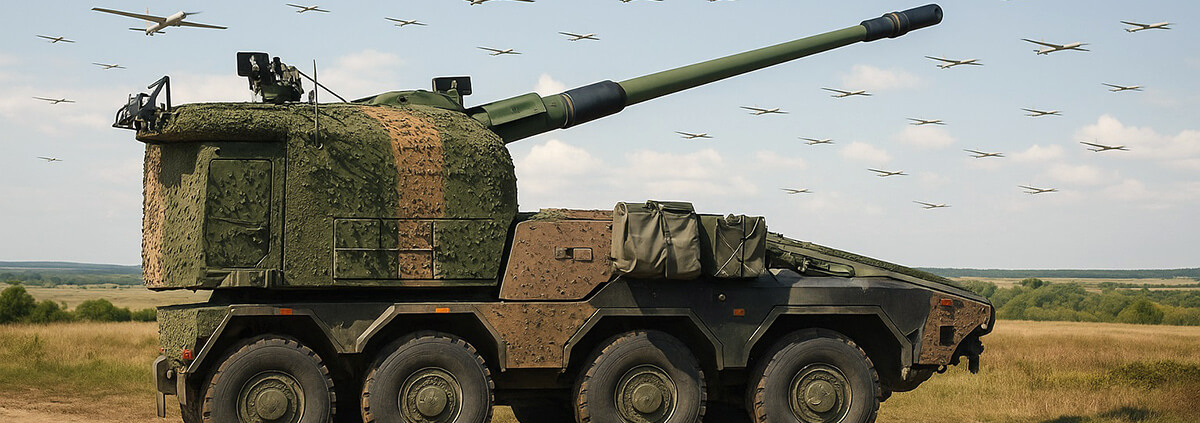Future of Artillery in the Context of Loitering Munition
By Eugen Neuendank and Andreas Alzner //
Introduction and Problem Statement:
For centuries, artillery has been regarded as the “King of the Battle” – a branch of service that combines effect, precision, and range. The Bundeswehr’s strategic focus on overseas missions and stabilization operations in the 2000s, along with the gradual downsizing of its artillery forces, led to a significant backlog in innovation and modernization.
The security-policy shift triggered by Russia’s illegal war of aggression against Ukraine marks Germany’s return to collective and national defense. This policy-shift forces both Germany and its NATO partners to reassess their artillery capabilities. The Bundeswehr is responding accordingly: the planned future structure of the German Army (“Zielbild Heer”) envisions a substantial growth of the artillery force – from currently five to a total of ten artillery battalions.
The ongoing war in Ukraine provides valuable insights: estimates suggest that around 80% of casualties on both sides are caused by artillery. At the same time, the mass employment of unmanned systems – especially Loitering Munition Systems (LMS) – has fundamentally altered tactical and operational dynamics.
Against the backdrop of structural expansion and the rapid proliferation of UAVs, the question arises whether conventional tube and rocket artillery will be completely substituted in the future, or instead be integrated as part of an expanded, multi-domain capable effects system.
The Mission of the Artillery
The principle of “fire and movement” emerged during the First World War as a tactical foundation of infantry assaults and has retained its validity to this day. Artillery remains the primary provider of fire superiority and enables the maneuver of combat forces in the first place.
According to NATO doctrine, artillery has three core missions: “Fire Support” for maneuver elements, “Deep Fires” against targets in the enemy’s operational depth, and “Counter-Battery Fires” against enemy artillery. To maintain this mission profile in the future, the Bundeswehr has initiated the introduction of new artillery weapon systems and types of ammunition.
Technological Evolution of Unmanned Systems
Since the 1990s, unmanned aerial systems have undergone exponential technological development, transforming from pure ISTAR platforms (Intelligence, Surveillance, Target Acquisition and Reconnaissance) into reliable, precise, and comparatively cost-efficient weapon carriers.
Recent conflicts – particularly Nagorno-Karabakh (2020) and Ukraine (since 2022) – have cemented the importance of UAVs as an integral component of military operations. LMS combine reconnaissance and effect within a single system and significantly shorten the “Kill-Chain.”
Current generations of unmanned systems differ primarily in propulsion type, sensors, warhead configuration, and degree of autonomy.
Propulsion largely determines the range, speed, and endurance of unmanned systems. Conventional UAVs use electric motors and achieve flight times of 15–40 minutes while remaining agile and flexible. Fixed-wing drones with combustion engines or hybrid propulsion reach 6–40 hours of endurance and can cover several hundred kilometers. Experience in Ukraine shows: the longer a UAV can remain over a target area, the higher its hit probability – and therefore its operational value.
Sensor technology has experienced a quantum leap over the past five years. Whereas simple daylight cameras were once standard, modern systems employ thermal imaging and multispectral sensors. Behavioral, AI-based algorithms (Automatic Target Recognition, ATR) further support target detection and classification.
Warheads today range from a few hundred grams to several kilograms. Depending on target type, (tandem) shaped charges, fragmentation, or thermobaric warheads are used.
At the same time, it is evident that UAVs – despite significant technological progress – remain highly vulnerable to electronic warfare and modern air defense systems.
Artificial Intelligence and the Future of UAVs
Societal megatrends also shape the military: digitalization, miniaturization, and artificial intelligence (AI) are key elements of military progress. AI offers improvements and potential across all warfighting functions – Command & Control (C2), Intelligence, Fires, Movement & Maneuver, Protection and Sustainment. AI systems can fuse data from diverse sensors into real-time situational pictures, prioritize targets, provide recommendations, and – within defined authorization limits – act autonomously.
Combining UAVs into swarm formations will enable autonomously coordinated attacks by multiple systems, optimizing both target engagement and the use of available effectors.
Modern operational environments are characterized by high technological and tactical volatility, requiring continuous adaptation by all actors. Even today, C2, reconnaissance, and effectors are being enabled by AI-based algorithms to automatically adjust to changing influences. The concept of Software Defined Defense thus serves as a key mechanism to ensure agility, resilience, and endurance in future highly contested battlespaces.
UAVs and Artillery – Synergy or Substitution?
UAVs and artillery currently form a complementary capability pair whose respective strengths reinforce one another on the modern battlefield. While unmanned systems offer clear advantages in reconnaissance, precision, and flexibility, they remain structurally limited in endurance, mass, and resilience to weather, air defense, or electronic countermeasures. Conventional artillery, on the other hand, continues to provide the essential means for large-scale and sustained fire support and therefore remains an indispensable component of land operations.
Experiences from Ukraine demonstrate that the artillery of the future will not be defined by caliber, tube count, or rate of fire alone, but by its ability to detect targets faster, engage them faster, and reposition faster than before.
In the long term, the future does not lie in an “either-or” between artillery and UAVs, but in an integrated multi-domain approach: conventional artillery provides mass and endurance, while unmanned systems provide precision, flexibility, and information superiority. Only the combination of both elements creates an adaptive, resilient, and effective architecture for future battlefields.


